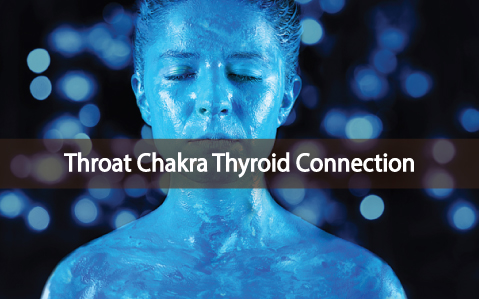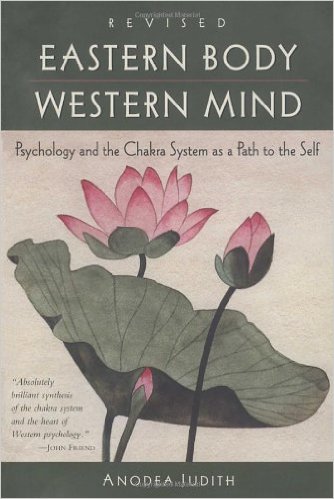
Thyroid Nation
The thyroid gland’s connection to your throat chakra.
The thyroid gland, located in the lower neck (throat chakra or fifth chakra), helps to regulate the metabolism by making the hormone thyroxine. As the thyroid hormone thyroxine enters various organs of the body such as the liver, muscles, and kidneys, some of it gets converted to another thyroid hormone known as triiodothionine.
The two so‑called thyroid hormones, thyroxine and triiodothionine are often abbreviated T4 and T3, respectively, to indicate the number of iodine atoms in each thyroid hormone molecule. The thyroid gland performs its function of regulating the metabolism through a feedback loop involving the hypothalamus and anterior portion of the pituitary gland. When thyroid hormone levels (T3 and T4) levels in the body become low, the hypothalamus secretes thyrotropin ‑releasing hormone (TRH), which in turn signals part of the pituitary gland to increase the level of thyrotropin, or thyroid‑stimulating hormone (TSH), in the bloodstream. Conversely, when thyroid hormone levels are high, the hypothalamus produces less TRH signaling the pituitary gland to secrete less TSH, which tells the thyroid gland to produce less T4.
An overactive thyroid, or hyperthyroidism, is caused by an overproduction of thyroid hormones, often a result of an autoimmune system disorder known as Graves’ disease. Symptoms of hyperthyroidism can include weight loss despite increased food intake; a tendency to feel warm when others are comfortable; irritability; heart palpitations; breathlessness; trembling hands; muscle weakness, especially in the thighs; increased, and often runny, bowel movements; irregular menstruation; itchy skin, thinning hair, brittle nails; watery, irritated, bulging eyes with dark bags underneath; and goiter.
Hypothyroidism, or underactive thyroid, occurs when the thyroid gland does not produce enough hormones. Symptoms can include weight gain; sensitivity to cold; fatigue, depression, and paranoia; slurred speech with a slow, husky voice; slowed heart rate; constipation; puffy eyes; heavy menstrual periods; high cholesterol; dry skin and hair; tingling of the nerves in the fingers; and inner‑ear problems.
According to Anodea Judith in Eastern Body, Western Mind, the central issue of the throat chakra is  communication. Therefore, if one’s self‑expression becomes out‑of‑balance, thyroid problems can result. Anodea lists many factors that may contribute to unbalanced self‑expression; for example, she mentions that even noise pollution in our immediate environment can dull our sensitivity to the truth within us. For if we are unable to “hear” our inner truth, how can we express that truth? Additionally she lists several home environments destructive to the developing child’s fifth‑chakra health: environments that stifle creativity such as a family with overly protective parents; environments that foster guilt and shame such as a home with a critical parent; environments that burden children with secrets to keep or taboo topics such as in families of incest or physical abuse in which children are threatened not to divulge the atrocities; environments with inconsistencies, lies, or mixed messages; fearful environments such as a quarrelsome home; and because children learn by being conversed with, environments of neglect.
communication. Therefore, if one’s self‑expression becomes out‑of‑balance, thyroid problems can result. Anodea lists many factors that may contribute to unbalanced self‑expression; for example, she mentions that even noise pollution in our immediate environment can dull our sensitivity to the truth within us. For if we are unable to “hear” our inner truth, how can we express that truth? Additionally she lists several home environments destructive to the developing child’s fifth‑chakra health: environments that stifle creativity such as a family with overly protective parents; environments that foster guilt and shame such as a home with a critical parent; environments that burden children with secrets to keep or taboo topics such as in families of incest or physical abuse in which children are threatened not to divulge the atrocities; environments with inconsistencies, lies, or mixed messages; fearful environments such as a quarrelsome home; and because children learn by being conversed with, environments of neglect.
Yoga for Fifth Chakra Health, according to Anodea Judith, because the neck, where the fifth chakra (throat chakra) is located, provides a narrow passageway for conducting energy between the mind and the heart, it is prone to muscular tightness. Therefore, before working with the fifth chakra, it helps to loosen surrounding muscles by doing neck rolls or neck stretches. When practicing the stretches remember to exaggerate and slow the gestures to gently stretch and loosen muscles.
Begin by finding a comfortable seat, perhaps crossing the legs and sitting in sukhasana. I like to sit on a blanket or two because my hamstring muscles often feel tight, and the added height the blankets provide help me maintain the healthy natural curve in my lower back. Next, I bring my awareness to my breath: When inhaling I like to lengthen my spine, visualizing being pulled up by a string attached to the crown of my head. When exhaling I focus on relaxing my shoulders‑this helps counter the tendency for one to hunch up one’s shoulders when practicing neck stretches. Also, when exhaling I like to focus on softening my eyes and the muscles of my face. As my spine lengthens and my body and mind relax, I begin practicing the neck stretches. The three movements of the neck are called yes, no and maybe. The first one is dropping the chin toward the chest and then lifting the chin (yes); the second movement is keeping the chin level and turning the head side to side so the chin moves toward the shoulder (no); the third movement is dropping the ear side to side toward the shoulder (maybe). The neck stretches can also be practiced lying down on one’s back. Lying down provides a more effective posture for side‑to‑side neck stretches because the neck is better able to relax when the floor does the work of supporting the neck. Some other yoga poses that may be beneficial for your thyroid are: Head lift, roaring lion’s pose, bridge pose, shoulderstand, fish pose.
In general, practicing proper postural alignment (especially at the fifth chakra) and working with yoga postures that direct energy to the throat will naturally help organs associated with the fifth chakra including the thyroid gland.
Chanting provides another means of balancing the 5th Chakra (Throat Chakra)
The throat serves as a conduit between the physical, or lower chakras, and the higher conscious, or upper chakras. Anodea Judith states that with chanting
“our individuated consciousness expands to merge with the greater consciousness and rhythm of life.”
 Furthermore, chanting the seed sound, or bija mantra, associated with a chakra is known to help balance the particular chakra, and the bija mantra for the fifth chakra is “ham.” (pronounced hum). Also, pranayama, or breathing exercises, particularly ujjayi (victorious) breathing help to tone the thyroid and parathyroid glands. Brehmari hum (bee‑humming breath) and sitali (curled tongue breath) breathing are also known to help balance the fifth chakra.
Furthermore, chanting the seed sound, or bija mantra, associated with a chakra is known to help balance the particular chakra, and the bija mantra for the fifth chakra is “ham.” (pronounced hum). Also, pranayama, or breathing exercises, particularly ujjayi (victorious) breathing help to tone the thyroid and parathyroid glands. Brehmari hum (bee‑humming breath) and sitali (curled tongue breath) breathing are also known to help balance the fifth chakra.
When working with healing disease, it helps to be aware of all available therapies. Therapies from traditional medicine and from holistic health fields can be equally valid at different times depending on the situation. However, I believe that in general we who live in modern western cultures tend to rely on traditional medicine too much for quick and easy “cures.” I am especially grateful for the healing benefits of yoga, which I believe has helped my throat, thyroid gland function.
**This article originally featured on SunandMoonStudio.com**
Questions or anything to add about the thyroid gland and throat chakra? We want your thoughts in the comments section–Please!




